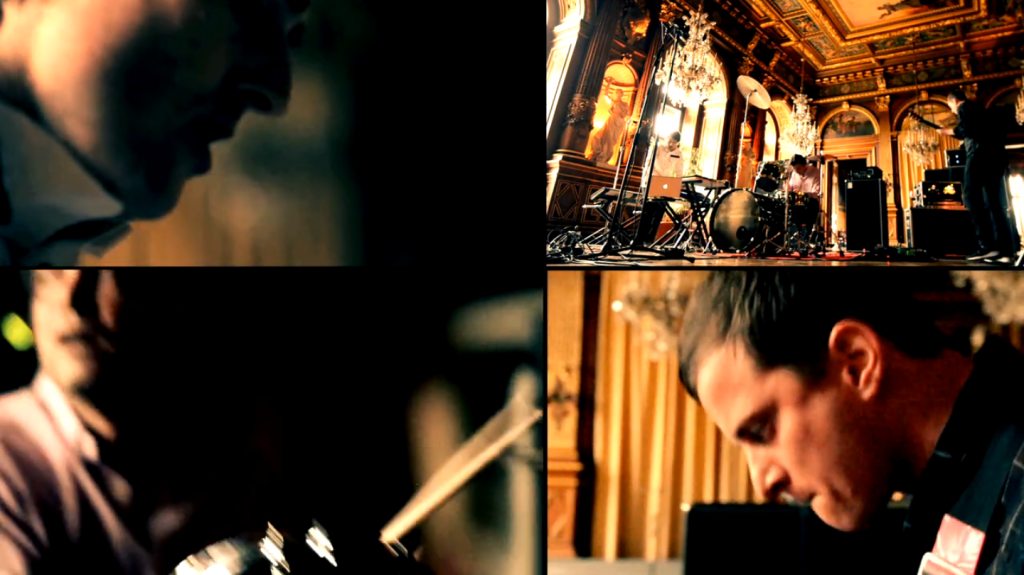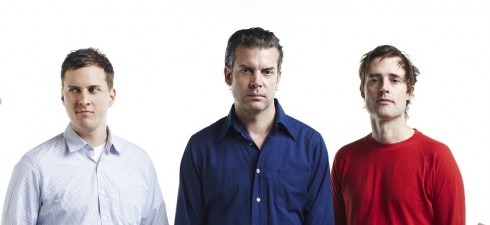From the packed-in floor of a dark club (under Victorian railway tracks), and through the dancing columns of sound and light, the three members of Battles appear as conjurors, athletes, inventors, and heroes. Playing mostly material from their brand-new album (released this week) ‘Gloss Drop‘, their music fuses layer over layer, rising from their amplifiers in hypnotic loops, mixing with John Stanier’s crunching and irresistible drum beats. His minimal kit defies the energy and focus of his performance in every track: his body hunched over in the intensity of his hi-hat/snare rhythms. When he rise to his feet to hit his crash cymbal (set at maximum height on its stand), the effect is thrilling. Dave Konopka likewise, often kneels at his array of effects pedals, in profile for the audience and to the right of the stage. The sounds that emerge are neither recognisibly guitar nor machine: but exist in Konopka’s control, in process of play. To our left, Ian Williams brings his guitar and two keyboards into synthesis, tapping frets one moment, next with hands dancing on upwardly angled keys on either side. He kicks the air on the drop, as if sending out the shockwaves that make the whole crowd ripple. We are enraptured.
 ‘Math rock‘, ‘Prog rock’ or ‘Post-rock’ are terms that might suggest a cerebral, wrought style, calculating and answering. Yet the brilliance of Battles is that (especially) in performance, they are anything but cold. The construction of their material is designed to connect, ‘mixing/ memory and desire’, provoking and energising the traditions upon which they draw. The new album contains vocal performances from Gary Numan, Kazu Makino (of Blonde Redhead) and Japanese visual artist Yamakata Eye, among others. They join the gig via ten-foot looped video projections at the back of the stage, controlled by Williams’ synth machinations. The quotations are perfectly integrated, riding through the beats and sounds: dropping out into silence, and returning to electrifying crescendo.
‘Math rock‘, ‘Prog rock’ or ‘Post-rock’ are terms that might suggest a cerebral, wrought style, calculating and answering. Yet the brilliance of Battles is that (especially) in performance, they are anything but cold. The construction of their material is designed to connect, ‘mixing/ memory and desire’, provoking and energising the traditions upon which they draw. The new album contains vocal performances from Gary Numan, Kazu Makino (of Blonde Redhead) and Japanese visual artist Yamakata Eye, among others. They join the gig via ten-foot looped video projections at the back of the stage, controlled by Williams’ synth machinations. The quotations are perfectly integrated, riding through the beats and sounds: dropping out into silence, and returning to electrifying crescendo.
In this space, time rides out over sensation, leaving us shocked, stranded. We measure the distance from our entry to this place by the saturation of perspiration on Stanier’s shirt and hair, and the emptying drinks, the plastic cups vibrating more and more in our hands, awash in successive tides of bass. When Battles leave the stage, we demand more: and Williams and Konopka return to another offering, presumably while Stanier recuperates. When the drummer emerges the club erupts, and celebrates with a final, explosive number. Finally the roadies turn the amps off: leaving us stunned. People don’t talk much, but laugh, look around for points of reference, and file out to the dark density of the London streets.
Back in time, I am left with the physical and connective impressions of the evening. I’m haunted by the depth of the drum beats and keyboard sequences, building and repeating in super-human spirals like DNA, as essential as the code of our entire beings. I draw inspiration from the impressions of improvised composition and design: the flow of instruments inexplicably colliding into the tightest of contrapuntal musical syntheses. To me, these are the conflicts that the band’s name references: mind and body, tradition and revolution, organisation and radical freedom. After this performance, we all feel victorious: as if some impossible answer has been transmitted in code, through our shocked ears, eyes and chests.
In conclusion, enjoy this video, promoting the track ‘Ice Cream’ from the new album. The vocalist is Matias Aguayo.
;
